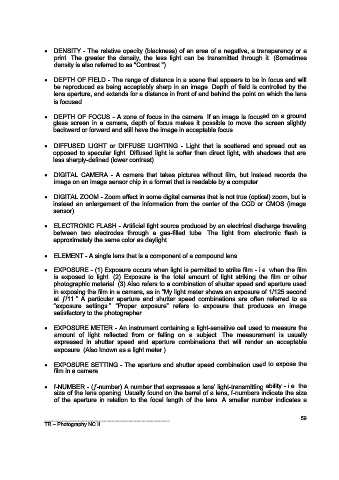Page 515 - aREA ix eXHIBITS
P. 515
DENSITY - The relative opacity (blackness) of an area of a negative, a transparency or a
print. The greater the density, the less light can be transmitted through it. (Sometimes
density is also referred to as "Contrast.")
DEPTH OF FIELD - The range of distance in a scene that appears to be in focus and will
be reproduced as being acceptably sharp in an image. Depth of field is controlled by the
lens aperture, and extends for a distance in front of and behind the point on which the lens
is focused.
DEPTH OF FOCUS - A zone of focus in the camera. If an image is focused on a ground
glass screen in a camera, depth of focus makes it possible to move the screen slightly
backward or forward and still have the image in acceptable focus.
DIFFUSED LIGHT or DIFFUSE LIGHTING - Light that is scattered and spread out as
opposed to specular light. Diffused light is softer than direct light, with shadows that are
less sharply-defined (lower contrast).
DIGITAL CAMERA - A camera that takes pictures without film, but instead records the
image on an image sensor chip in a format that is readable by a computer.
DIGITAL ZOOM - Zoom effect in some digital cameras that is not true (optical) zoom, but is
instead an enlargement of the information from the center of the CCD or CMOS (image
sensor).
ELECTRONIC FLASH - Artificial light source produced by an electrical discharge traveling
between two electrodes through a gas-filled tube. The light from electronic flash is
approximately the same color as daylight.
ELEMENT - A single lens that is a component of a compound lens.
EXPOSURE - (1) Exposure occurs when light is permitted to strike film - i.e. when the film
is exposed to light. (2) Exposure is the total amount of light striking the film or other
photographic material. (3) Also refers to a combination of shutter speed and aperture used
in exposing the film in a camera, as in “My light meter shows an exposure of 1/125 second
at ƒ/11.” A particular aperture and shutter speed combinations are often referred to as
“exposure settings.” “Proper exposure” refers to exposure that produces an image
satisfactory to the photographer.
EXPOSURE METER - An instrument containing a light-sensitive cell used to measure the
amount of light reflected from or falling on a subject. The measurement is usually
expressed in shutter speed and aperture combinations that will render an acceptable
exposure. (Also known as a light meter.)
EXPOSURE SETTING - The aperture and shutter speed combination used to expose the
film in a camera.
f-NUMBER - (ƒ-number) A number that expresses a lens’ light-transmitting ability - i.e. the
size of the lens opening. Usually found on the barrel of a lens, f-numbers indicate the size
of the aperture in relation to the focal length of the lens. A smaller number indicates a
________________________________________________ 59
TR – Photography NC II

